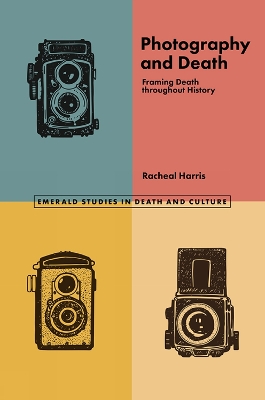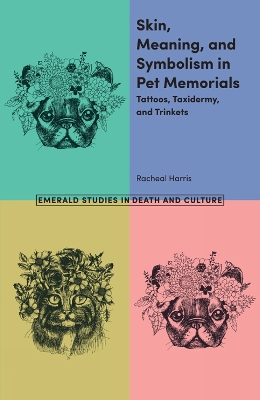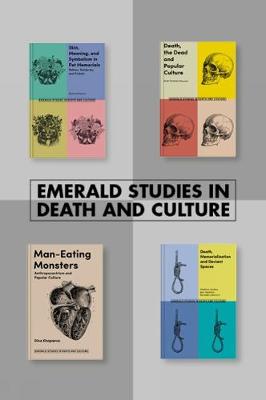Emerald Studies in Death and Culture
3 total works
Photography represents a medium in which the moment of death can be captured and preserved, the image becoming a mechanism through which audiences are beguiled by the certainty of their own mortality. Examining a spectrum of post-mortem images, Photography and Death considers various ways in which the death image has been framed and what these styles communicate about changing social attitudes related to dying, mourning and the afterlife.
Presenting a fresh perspective on how we might view death photography in the context of our contemporary cultural milieu, this book brings together a range of historical examples to create a richer narrative of how we see, understand and discuss death in both the private and public forum. Building upon existing publications which relate explicitly to the study of death, dying and cultures of mourning, the book discusses topics such as post-mortem portraiture, the Civil War, Spiritualism and lynching. These are positioned alongside contemporary representations of death, as seen in celebrity death images and forensic photography. Uncovering an important historical contrast, in which modern notions of death are a comment on ownership or an emotionless, clinical state, Harris highlights the various ways that the deceased body is a site of contestation and fascination.
An engaging read for students and researchers with an interest in death studies, this book represents a unique account of the various ways that attitudes about death have been shaped through the photographic image.
Presenting a fresh perspective on how we might view death photography in the context of our contemporary cultural milieu, this book brings together a range of historical examples to create a richer narrative of how we see, understand and discuss death in both the private and public forum. Building upon existing publications which relate explicitly to the study of death, dying and cultures of mourning, the book discusses topics such as post-mortem portraiture, the Civil War, Spiritualism and lynching. These are positioned alongside contemporary representations of death, as seen in celebrity death images and forensic photography. Uncovering an important historical contrast, in which modern notions of death are a comment on ownership or an emotionless, clinical state, Harris highlights the various ways that the deceased body is a site of contestation and fascination.
An engaging read for students and researchers with an interest in death studies, this book represents a unique account of the various ways that attitudes about death have been shaped through the photographic image.
In response to increased academic interest in the fields of death studies, memorial studies, and human and animal studies, Skin, Meaning and Symbolism in Pet Memorials examines the mourning rituals which exist between people and their domestic pets.
Paying close attention to the changing role and increased prominence of the companion animal in the domestic setting, each chapter considers a different form of companion animal memorialization, linking modern practices such as tattooing to historical examples of animal focused memento mori, particularly taxidermy. The final chapter adopts a forward focus in its provision of a framework for future studies related to how death and memorialization rituals are increasingly coming to occupy the digital space. While skin and touch are the focal points of many encounters explored in the text, what becomes evident is how the virtual realm is increasingly intruding into the touch experience. As a result, the posthumous, online afterlives of pets are set to become a social issue of increasing significance to the death and mourning experience.
This work meets the needs of academics, post-graduate students and general readers alike, appealing to anyone with an interest in death studies, popular culture, tattooing and human and animal studies.
Paying close attention to the changing role and increased prominence of the companion animal in the domestic setting, each chapter considers a different form of companion animal memorialization, linking modern practices such as tattooing to historical examples of animal focused memento mori, particularly taxidermy. The final chapter adopts a forward focus in its provision of a framework for future studies related to how death and memorialization rituals are increasingly coming to occupy the digital space. While skin and touch are the focal points of many encounters explored in the text, what becomes evident is how the virtual realm is increasingly intruding into the touch experience. As a result, the posthumous, online afterlives of pets are set to become a social issue of increasing significance to the death and mourning experience.
This work meets the needs of academics, post-graduate students and general readers alike, appealing to anyone with an interest in death studies, popular culture, tattooing and human and animal studies.
Emerald Studies in Death and Culture Book Set (2018-2019)
by Brian Parsons, Ruth Penfold-Mounce, Matthew Spokes, and Racheal Harris
Published 10 August 2020
Is it still impolite in our culture to talk about death?
We think not! In fact Death and Mortality don't gate-crash Culture's party they're definitely invited.?
Unearthing themes which are ever present but not always explicitly acknowledged, these studies bring together research from across the arts, humanities and social sciences, exploring aspects of death and mortality and their representation and influence across popular culture and the society in which we live.
Highly readable and relevant for a broad spectrum of scholars and researches working across multiple disciplines from sociology and criminology to art history and film studies.
Titles included in this set:
We think not! In fact Death and Mortality don't gate-crash Culture's party they're definitely invited.?
Unearthing themes which are ever present but not always explicitly acknowledged, these studies bring together research from across the arts, humanities and social sciences, exploring aspects of death and mortality and their representation and influence across popular culture and the society in which we live.
Highly readable and relevant for a broad spectrum of scholars and researches working across multiple disciplines from sociology and criminology to art history and film studies.
Titles included in this set:
- The Evolution of the British Funeral Industry in the 20th Century:From Undertaker to Funeral Director;
- Death, The Dead and Popular Culture;
- Death, Memorialization and Deviant Spaces;
- Skin, Meaning, and Symbolism in Pet Memorials:Tattoos, Taxidermy, and Trinkets;
- Man-Eating Monsters:Anthropocentrism and Popular Culture;


